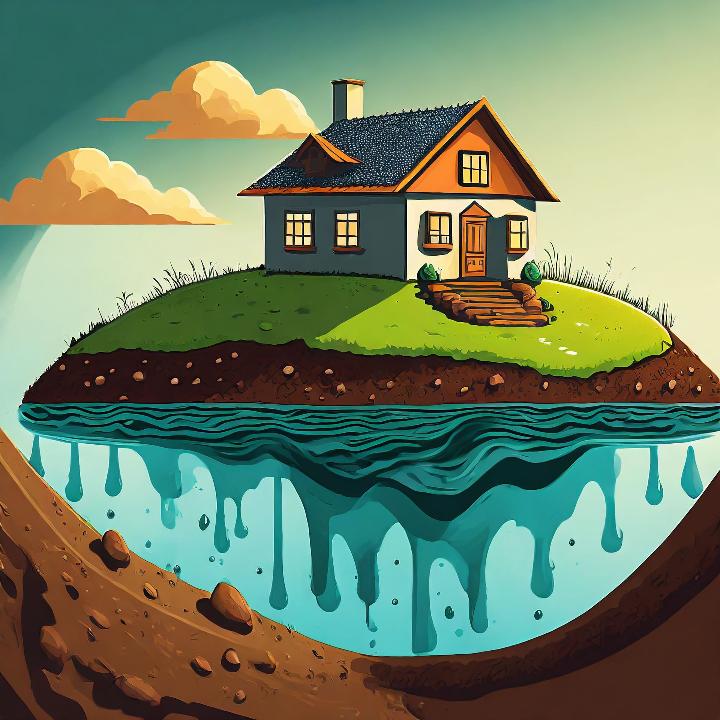
The water table is a crucial geological feature that influences various aspects of a property, including construction, drainage, and overall stability. In this comprehensive guide, we'll delve into the concept of the water table around houses, how it affects properties, and ways to manage its impact.
What is the Water Table on a House?
The water table refers to the level below the ground surface where the soil and rock are fully saturated with water. In the context of a house, the water table plays a significant role in determining the potential for groundwater seepage into basements or crawl spaces. Understanding its depth and fluctuations is essential for homeowners, builders, and engineers.
How Do I Find My Local Water Table?
Determining the depth of the water table beneath your property requires various methods:
- Well Logs and Boreholes: Well logs from neighboring wells or boreholes drilled in the vicinity can provide insights into the water table's depth. Professional drilling companies or geological surveys often have access to this data.
- Groundwater Monitoring Equipment: Sophisticated equipment, such as piezometers or groundwater monitoring wells, can directly measure the water table depth and fluctuations. These tools are typically used by hydrogeologists and environmental engineers.
- Observation of Surface Water Features: Natural surface water features like ponds, lakes, or streams can indicate the local water table's level. These features often align with the water table's elevation.
How Do I Lower the Water Table Under My House?
Lowering the water table beneath a house might be necessary to prevent issues like basement flooding or structural damage. However, altering the water table can be complex and might require professional guidance. Potential methods include:
- Installation of Drainage Systems: Properly designed drainage systems, such as French drains or sump pumps, can effectively manage excess groundwater and redirect it away from the property.
- Use of Wellpoints or Dewatering Wells: In some cases, wellpoints or dewatering wells are installed to lower the water table temporarily during construction or to address high water table issues.
- Grading and Landscape Adjustments: Modifying the property's landscape through grading can help direct surface water away from the house, reducing the impact of a high-water table.

How Do I Know if My Water Table is Low or High?
Determining whether a water table is low or high depends on various indicators:
- Well Water Levels: Monitoring the water levels in wells or boreholes can indicate changes in the water table's depth over time.
- Presence of Surface Water: Visible surface water in basements, crawl spaces, or low-lying areas after rainfall may suggest a high water table.
- Soil Moisture and Percolation Rates: Observation of soil moisture, slow drainage, or prolonged standing water can signal a high-water table.
Does the Water Table Rise When It Rains?
Yes, rainfall can significantly impact the water table. When it rains, excess water infiltrates the soil and gradually percolates downward until it reaches the water table, causing it to rise temporarily. The rate at which rainfall affects the water table depends on soil permeability, existing groundwater levels, and the intensity and duration of the rainfall.
How Long Does It Take Water to Get to the Water Table?
The time it takes for water to reach the water table varies based on multiple factors:
- Soil Type and Permeability: Porous soils, like sandy or gravelly soils, allow water to infiltrate more rapidly compared to dense clay soils.
- Distance from Ground Surface to Water Table: The depth of the water table determines how far water must travel vertically to reach it. Shallow water tables will experience quicker infiltration.
- Rainfall Intensity and Duration: Heavy rainfall over a short period can lead to rapid infiltration, whereas light and prolonged rainfall might take longer to impact the water table.
Understanding the dynamics of water movement through soil layers is crucial to predict how quickly rainwater will reach the water table.
In conclusion, the water table around a house plays a pivotal role in property management, construction, and environmental considerations. Being aware of its depth, fluctuations, and potential impacts empowers homeowners and professionals to make informed decisions about drainage, construction practices, and water management systems. Awareness of the local water table can help mitigate potential risks associated with groundwater and contribute to a more resilient property infrastructure.